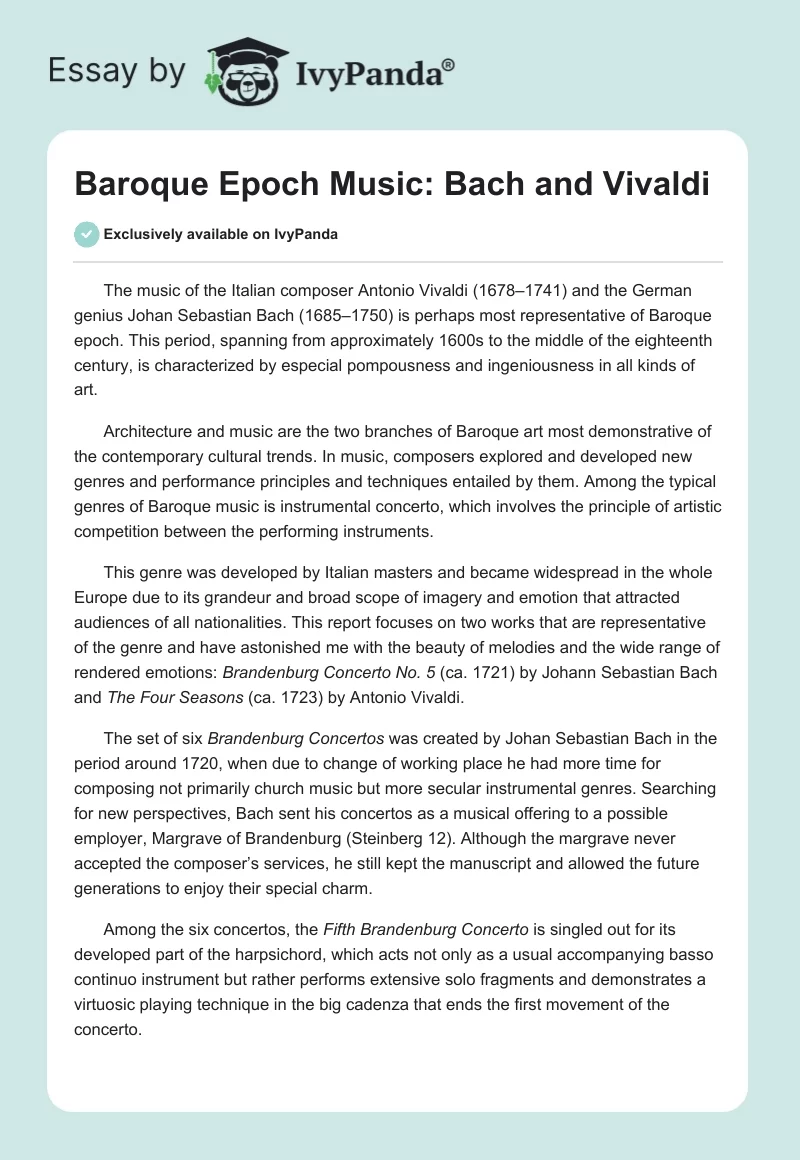The music of the Italian composer Antonio Vivaldi (1678–1741) and the German genius Johan Sebastian Bach (1685–1750) is perhaps most representative of Baroque epoch. This period, spanning from approximately 1600s to the middle of the eighteenth century, is characterized by especial pompousness and ingeniousness in all kinds of art.
Architecture and music are the two branches of Baroque art most demonstrative of the contemporary cultural trends. In music, composers explored and developed new genres and performance principles and techniques entailed by them. Among the typical genres of Baroque music is instrumental concerto, which involves the principle of artistic competition between the performing instruments.
This genre was developed by Italian masters and became widespread in the whole Europe due to its grandeur and broad scope of imagery and emotion that attracted audiences of all nationalities. This report focuses on two works that are representative of the genre and have astonished me with the beauty of melodies and the wide range of rendered emotions: Brandenburg Concerto No. 5 (ca. 1721) by Johann Sebastian Bach and The Four Seasons (ca. 1723) by Antonio Vivaldi.
The set of six Brandenburg Concertos was created by Johan Sebastian Bach in the period around 1720, when due to change of working place he had more time for composing not primarily church music but more secular instrumental genres. Searching for new perspectives, Bach sent his concertos as a musical offering to a possible employer, Margrave of Brandenburg (Steinberg 12). Although the margrave never accepted the composer’s services, he still kept the manuscript and allowed the future generations to enjoy their special charm.
Among the six concertos, the Fifth Brandenburg Concerto is singled out for its developed part of the harpsichord, which acts not only as a usual accompanying basso continuo instrument but rather performs extensive solo fragments and demonstrates a virtuosic playing technique in the big cadenza that ends the first movement of the concerto.
This cadenza, apart from demonstrating the performer’s technical mastery, also serves as an embodiment of the Baroque improvisational principle. When it was performed by the harpsichordist, I had the feeling that he was pouring out his splendid virtuosity as if impromptu. The other solo instruments, the flute and the violin, also receive space for self-expression, especially in the second movement of the Fifth Brandenburg Concerto, where they merge with the harpsichord in a lyrical meditation.
When listening, I managed to trace some genre allusions to the dances of Baroque suite: the dotted-note tread of the second movement reminds of the solemn sarabanda procession, and the three-beat lively motion of the final movement resembles the traditional gigue dance. Throughout the first and the last movement, the solo instruments seem to compete among each other as well as with the accompanying strings for thematic prevalence, which reflects the competitive nature of concert.
In the genre of instrumental concerto there were no rivals for the Italian master Antonio Vivaldi. Under the conditions of his employment with Ospedale della Pietà he was supposed to write two concertos per month: from here, inter alia, stems the enormous quantity of the works in this genre written by Vivaldi (“Antonio Vivaldi”). At times employing the method of descriptive, or program music, Vivaldi created concertos that were dedicated to rendering a certain event or phenomenon, often reflecting scenes of nature.
Among those program concertos, The Four Seasons gained especial popularity already in the eighteenth century with such prominent people as the French King Louis XV and the philosopher Jean-Jacques Rousseau (“Antonio Vivaldi”). This popularity is not surprising, since the concertos provide a vivid and expressive musical rendition of their literary program that is based on four sonnets probably written by the composer himself (“Antonio Vivaldi”).
The text of the sonnets is closely followed by the musical material reflecting all the changes in the scenery, the weather, and the atmosphere of the situation (Cunningam and Reich 382). Due to this outstanding descriptiveness of musical language, The Four Seasons were especially exciting for me to listen to and to track the change of time, place, weather, and mood that correspond to each season.
The first movement of Spring, inspired by the feeling of the nature’s awakening, bursts in the energetic movement of trills and staccatos of singing birds and the smooth passages of streaming water. The following movement, through its peaceful melody, illustrates a sleeping shepherd; the quiet scene is interrupted only by a barking dog, rendered by a violin.
Next, the peasants celebrate the beginning of year in an exciting folk dance that reminds of traditional Italian tarantella. Summer is all about heat and thunderstorms: the heat is depicted in the slow, as if lazy, phrases of the violin. The thunderstorm approaches throughout the two first movements in far-away roars of thunder (sudden loud bangs of the whole orchestra) and bursts through in the last part in the streaming passages that depict flowing water.
Autumn is yet another fest: the peasants celebrate harvest and again dance to a melody that reminds of the opening movement of Spring. Tired and drunk after their party, they fall asleep in the second movement, where only rarely the quietness is disrupted by occasional reminiscences of the festive melody (obviously some joyful revelers) — an especially comical effect that nearly made me laugh.
Finally, Autumn is concluded by a stylized scene of hunt, with horns blowing the attack on the wild. Winter sets in with a series of trills and repetitive motion, as if howling cold wind sets teeth chattering. After a peaceful second movement, which warmed me up with its placid melody of violin against a soft orchestra accompaniment, the chills return, reminding me of the inevitability of the nature’s events.
Works Cited
“Antonio Vivaldi; The Four Seasons.” baroquemusic.org. 13 March 2009. Web. <http://www.baroquemusic.org/vivaldiseasons.html>
Cunningham, Lawrence S., and John J. Reich. Culture and Values, Volume II: A Survey of the Humanities with Readings, 7th edition. Boston, MA: Wadsworth, 2009. Print.
Steinberg, Michael. The Concerto: A Listener’s Guide. New York, NY: Oxford University Press, 2000. Print.


